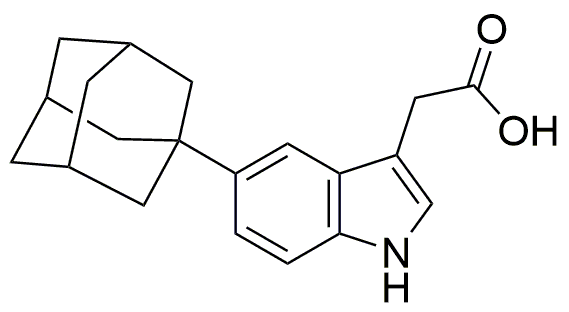5-Adamantyl-IAA is widely utilized in research focused on:
- Plant Growth Regulation: This compound acts as a plant growth regulator, promoting root and shoot development in various plant species, making it valuable in agriculture for enhancing crop yields.
- Pharmaceutical Research: It is explored in drug development for its potential therapeutic effects, particularly in treating conditions related to plant hormones, which can lead to innovative treatments.
- Biochemical Studies: Researchers use this compound to study the mechanisms of action of auxins, a class of plant hormones, helping to unravel complex biological processes.
- Environmental Science: It plays a role in understanding how plants respond to environmental stressors, aiding in the development of more resilient crop varieties.
- Horticulture: This chemical is applied in horticultural practices to optimize flowering and fruiting in ornamental and fruit-bearing plants, enhancing aesthetic and economic value.
Información general
Propiedades
Seguridad y normativas
Aplicaciones
5-Adamantyl-IAA is widely utilized in research focused on:
- Plant Growth Regulation: This compound acts as a plant growth regulator, promoting root and shoot development in various plant species, making it valuable in agriculture for enhancing crop yields.
- Pharmaceutical Research: It is explored in drug development for its potential therapeutic effects, particularly in treating conditions related to plant hormones, which can lead to innovative treatments.
- Biochemical Studies: Researchers use this compound to study the mechanisms of action of auxins, a class of plant hormones, helping to unravel complex biological processes.
- Environmental Science: It plays a role in understanding how plants respond to environmental stressors, aiding in the development of more resilient crop varieties.
- Horticulture: This chemical is applied in horticultural practices to optimize flowering and fruiting in ornamental and fruit-bearing plants, enhancing aesthetic and economic value.
Documentos
Hojas de datos de seguridad (HDS)
La SDS proporciona información de seguridad completa sobre la manipulación, el almacenamiento y la eliminación del producto.
Especificación del producto (PS)
La PS proporciona un desglose completo de las propiedades del producto, incluida la composición química, el estado físico, la pureza y los requisitos de almacenamiento. También detalla los rangos de calidad aceptables y las aplicaciones previstas del producto.
Certificados de análisis (COA)
Busque certificados de análisis (COA) ingresando el número de lote del producto. Los números de lote y de partida se pueden encontrar en la etiqueta de un producto después de las palabras "Lote" o "Lote".
Número de catálogo
Número de lote/lote
Certificados de origen (COO)
Este certificado de origen confirma el país en el que se fabricó el producto y también detalla los materiales y componentes utilizados en él y si se deriva de fuentes naturales, sintéticas u otras fuentes específicas. Este certificado puede ser necesario para cumplir con las normativas aduaneras, comerciales y regulatorias.
Número de catálogo
Número de lote/lote
Hojas de datos de seguridad (HDS)
La SDS proporciona información de seguridad completa sobre la manipulación, el almacenamiento y la eliminación del producto.
DownloadEspecificación del producto (PS)
La PS proporciona un desglose completo de las propiedades del producto, incluida la composición química, el estado físico, la pureza y los requisitos de almacenamiento. También detalla los rangos de calidad aceptables y las aplicaciones previstas del producto.
DownloadCertificados de análisis (COA)
Busque certificados de análisis (COA) ingresando el número de lote del producto. Los números de lote y de partida se pueden encontrar en la etiqueta de un producto después de las palabras "Lote" o "Lote".
Número de catálogo
Número de lote/lote
Certificados de origen (COO)
Este certificado de origen confirma el país en el que se fabricó el producto y también detalla los materiales y componentes utilizados en él y si se deriva de fuentes naturales, sintéticas u otras fuentes específicas. Este certificado puede ser necesario para cumplir con las normativas aduaneras, comerciales y regulatorias.


